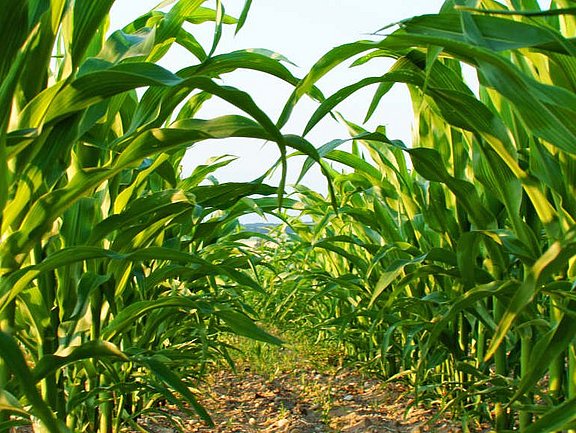Corn silage bale feed quality
How can I contribute to ideal feed quality as a farmer?
Feed quality in corn silage bales and therefore economic and animal health aspects play a major role in agriculture. Milk production and the meat industry are significantly affected, possibly even the human food chain in the future. Various factors that influence feed quality must be considered. These start with the cultivation of plants, up to the proper storage of the silage.
Mycotoxins
What are mycotoxins?
Mycotoxins are metabolites of molds. Even in small quantities they can have a toxic effect on animals and are undesirable in feed. Mycotoxins can have harmful effects on the liver (hepatotoxic) and to the unborn (teratogenic). However, these nuisances cannot be completely avoided. Infestation is worse in years with more rain than in dry periods. Mycotoxin contamination depends on precipitation, temperature, soil type and cultivation method. If animals eat bales of contaminated feed, the by-products can enter the human food chain via milk or meat down the road.
What are the different types of mycotoxins?
Mycotoxins are divided into field fungi and storage fungi.
Field fungi:
Field fungi need a specific moisture content to further develop, and then die relatively quickly with drying. The most common toxins in corn silage come from fusarium mold. It can infect all types of grains. It occurs on weakened or dying plants. The most common mycotoxins in corn silage include:
Deoxynivalenol DON (can affect growth and cause central nervous system damage)
Zearalenone ZEA (causes fertility problems)
Storage fungi:
Storage fungi can also thrive in low humidity conditions. They require poor hygienic conditions, air ingress and condensation to thrive and spread. Storage fungi in corn silage include, for example, aspergillus and penicillium molds. Their most common mycotoxins are:
Aflatoxins (cause severe growth disorders)
Ochratoxin A (causes kidney disease and inflammation)
Mycotoxins and corn silage
Since corn silage has a fairly long vegetation period, it is ideal for the spread of a wide variety of fungi. The abovementioned DON and ZEA mycotoxins are often detected on the stems and lower leaves at harvest. An increasing DM content at harvest or a wet year cause the levels to increase sharply at the end of vegetation. For example, during ensiling, fusarium toxins die quickly and cannot further develop. Toxins formed up to that point, however, get into the crop and persist due to their thermostability. Then, storage fungi develop if air enters the silage bales due to careless work or if condensation occurs. The quality of the silage suffers as a result.
Cultivation and care management
As a farmer, what crop management measures can I take to make an impact?
The previous crop and crop rotation must always be considered when it comes to fungal infestation. Fungal infestation is more likely to occur in grain-corn rotations. Multi-year cultivation of feed plants or extended crop rotations through intercropping are one of the first sensible crop management measures. Followed by a selection of varieties and soil cultivation. It is important to choose wheat varieties that are less susceptible to fusarium in the previous crop of grain. Soil cultivation without ploughing is conducive to less transmission because the infectious material is not spread around. Continuous conservation soil cultivation creates a viable soil structure and supports soil organisms. However, intensive post-harvest composting processes are necessary to contain the overall incidence and prevent further transmission. Promoting rotting of straw with intensive shredding and mixing is recommended. It is then easier for soil organisms to process.
Harvest and processing
How can harvesting and processing help improve quality?
When harvesting corn silage, about 40 cm of stalks should remain in the field. This is where most of the fungi are located. In addition, this minimizes the introduction of impurities such as soil residues. During further processing, it is good not to exceed a moisture content of 13% for the crop and, if necessary, to use silage additives to support the overall process. Our G-1 F125 Kombi and the LT-Master can each be retrofitted with a metering unit.
Further, correct and sufficient compression of the silage is necessary. You can also read the article Round bale silage or bunker silo? on our website.
Storage
What should be considered during storage?
Some aspects must also be noted when storing corn silage bales:
Bales should be stored on a level, firm and clean substrate. Condensation and mold are largely prevented when placed on the front side with a small distance between the round bales. Quality can thus be preserved.
Our Tips on how to achieve the perfect bale deposit are also of interest here.
Pests
Pests on bales
Pests such as rodents and birds can be kept to a minimum with good bale storage. However, it makes sense to minimize pest infestation as much as possible during cultivation. This is another way to prevent fungi from gaining entry into the plant, which is weakened by the pests. Protecting the seed from corn rootworm, or controlling it later, will protect your crop, as will chemical (insecticides) or biological (ichneumon wasps) control of European corn borer.
Conclusion
As always, it is important to keep an eye on the entire crop throughout. Constant observations and maintaining a high standard of cleanliness prevents plants from becoming weakened and thus major losses of your crop. Optimal storage afterwards completes the chain and ensures high-quality feed and healthy livestock.
What other topics would you like to know more about?
Email us your suggestions at marketing@goeweil.com










